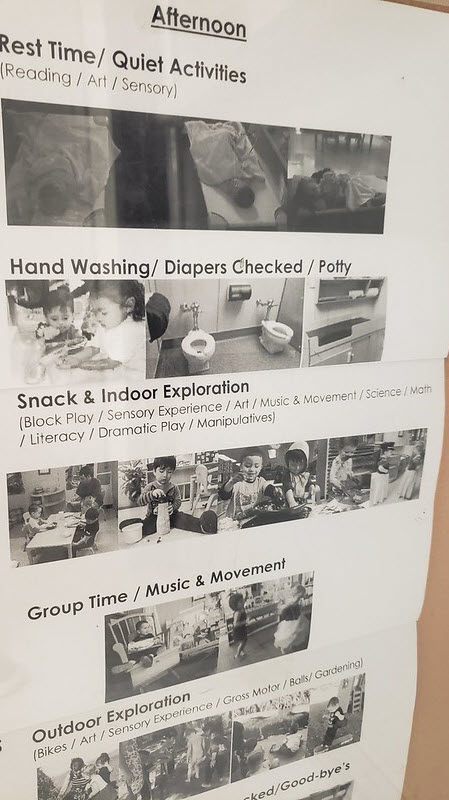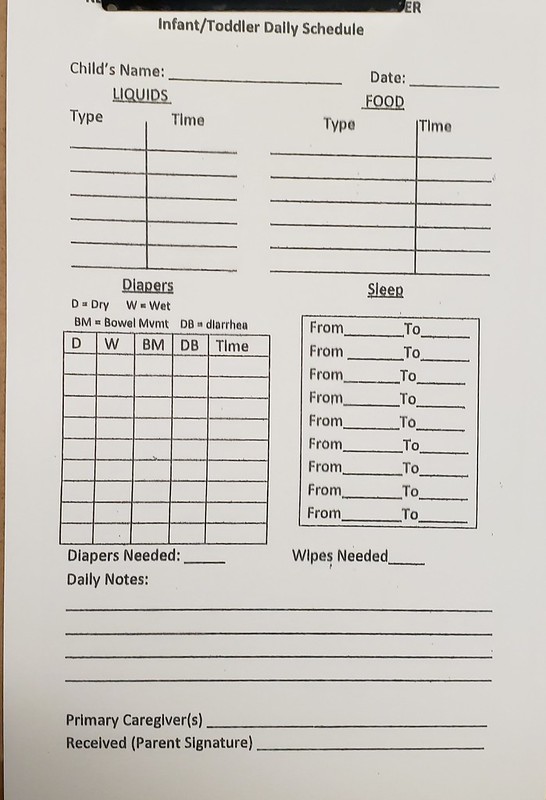25.3: The Daily Schedule
- Page ID
- 142758
The Importance of Schedules
Many states require child care programs to have written daily schedules. The National Association for the Education of Young Children (NAEYC) encourages practices in which “the curriculum guides the development of a daily schedule that is predictable yet flexible and responsive to individual needs of the children” (NAEYC, 2015, p. 9). How do you develop a daily schedule for a group of infants and toddlers who are each on their own timetable? This is an important question because infants and toddlers have not yet developed the ability to manage their own feelings and behavior. For infant and toddler care caregivers, creating a daily schedule that is based on responsive care routines makes good sense. Early learning researchers widely agree that adults can best support early learning when a child’s interests are central to the learning experience (Shonkoff & Phillips, 2000).[1]

The daily schedule orders the events that take place each day. It outlines how the daily events are expected to flow, the order in which they happen, and for how long (although not necessarily the exact times).
Schedules are important because they :
- provide consistency and predictability, which help infants and toddlers develop a sense of trust and security;
- give caregivers, family child care providers, and home visitors a framework for planning and making good use of time spent with children; and
- provide a link between home and school, and reassure families, especially those whose children are in group care, about what their children are doing during the day. [1]
As you incorporate the unique care routines and rhythms of each infant and toddler in your care, you can begin to create individualized daily schedules, which is an important basis of high-quality caregiving (Raikes & Edwards, 2009). Keep in mind, to respond to changing individual needs of infants, it’s important to allow room for flexibility during the day. Anything too rigid will create undue stress for babies and tension for the caregivers who try to adhere to a set plan. For example, very young infants, who are on their own sleep schedules, may sleep through outside time and be ready to play and engage while the older infants nap. This does not mean there is no order or system; you are still making sure that all the daily care routines are happening. However, if one infant needs to eat or sleep sooner than others, you can adapt. Maybe a 2-year-old with a new baby brother at home needs a little more cuddle time than he did last week. Or an infant needs breathing treatments at certain times in the day and you have adjusted the schedule to read books to him and other toddlers during his therapy.[1]
While consistency and predictability are important characteristics of schedules, flexibility is just as important. This means that schedules can be modified in the moment to meet individual children’s needs or group needs, take advantage of “teachable moments,” and maintain a consistent and an unhurried pace. Schedules can also be modified in the long term as children’s needs and abilities change over time. [1]

Other characteristics of schedules, in particular for group care settings, include:
- major events occurring in the same order every day;
- sufficient time for routine care and transitions from one event to the next;
- balance between active and quiet times;
- opportunities to be alone, with a familiar adult, and with small groups of children; and
- opportunities to spend time outdoors.
Infants follow individualized schedules for sleeping, eating, diapering, and playing. A one-size-fits-all schedule would not be appropriate for them. This means that caregivers and family child care providers will likely have as many schedules as they have infants. For example, at any given time, one infant may be napping, another getting her bottle, and a third playing with a soft block on the floor.23 Families are primary sources of information about when their children eat, nap, are most active, and so on; in culturally consistent care, the timing of these caregiving routines and awake times for play in a group care setting should match as closely as possible to when they occur at home. Cultural continuity, particularly for young children, allows for uninterrupted development of children’s self-identity. Managing these individual schedules requires some planning. Knowledge about individual children can help staff predict when each child may get tired, get hungry, or need a diaper change; in turn, staff can take steps to prepare, such as get diapering supplies or cots out in advance or coordinate care responsibilities with another adult. [2]
Schedules for toddlers in group care may be more consistent and group oriented. For example, toddlers may eat meals together, go outside together, take naps at the same time, and come together for short times in small groups for stories, music, and movement experiences. Caregivers and family child care providers may create simple visual schedules with photos or drawings that show the daily events and when they occur to help children understand what happens and when. However, toddlers, still have individual timetables for routine care as well as times when they need to be away from the group or one-on-one with a familiar, trusted adult. Honoring toddlers’ individual schedules and home culture is as important as honoring infants’ schedules and home culture. Family input continues to play a central role.[2]
One important aspect of the daily schedule is transitions. Infants and toddlers experience many transitions (changes) during the day, for example, between routines and experiences, arrivals and departures, and going outside to play and coming back in. Home visits include transitions, too! Each child experiences and handles transitions differently; change is harder for some children than for others, so transitions can be some of the most challenging times of the day. Infants and toddlers rely on adults to provide a sense of safety and continuity as they experience change; individualizing transitions is one way to provide the stability infants and toddlers need.
[1] Image by Amanda Taintor is licensed CC BY-NC
[1] Early Head Start National Resource Center.(n.d) [Individualizing care for infants and tollders]. Is in the public domain

